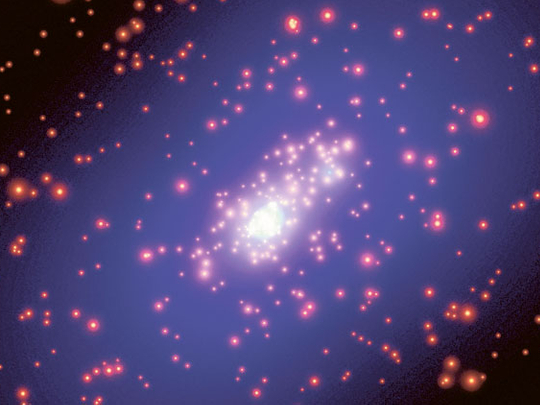
1 What is the universe made of?
Astronomers don’t know what 95 per cent of the universe is made of. Atoms, which form everything we see around us, only account for a measly 5 per cent. Over the past 80 years it has become clear that the substantial remainder is comprised of two shadowy entities – dark matter and dark energy. The former acts as an invisible glue, binding galaxies and galaxy clusters together. The latter is pushing the universe’s expansion to ever greater speeds.
2 How did life begin?
Four billion years ago, something started stirring in the primordial soup. A few simple chemicals got together and made biology – the first molecules capable of replicating themselves appeared. We humans are linked by evolution to those early biological molecules..
3 Are we alone in the universe?
Perhaps not. Astronomers have been scouring the universe for places where water worlds might have given rise to life, from Europa and Mars in our solar system to planets many light years away. Radio telescopes have been eavesdropping on the heavens and astronomers are now able to scan the atmospheres of alien worlds for oxygen and water.
4 What makes us human?
Just looking at your DNA won’t tell you – the human genome is 99 per cent identical to a chimpanzee’s and, for that matter, 50 per cent to a banana’s. We do, however, have bigger brains than most animals – not the biggest, but packed with three times as many neurons as a gorilla (86 billion to be exact). A lot of the things we once thought distinguishing about us – language, tool-use, recognising yourself in the mirror – are seen in other animals.
5 What is consciousness?
We’re still not really sure. We do know that it’s to do with different brain regions networked together rather than a single part of the brain. The thinking goes that if we figure out which bits of the brain are involved and how the neural circuitry works, we’ll figure out how consciousness emerges, something that artificial intelligence and attempts to build a brain neuron by neuron may help with.
6 Why do we dream?
We spend around a third of our lives sleeping. Considering how much time we spend doing it, you might think we’d know everything about it. But scientists are still searching for a complete explanation of why we sleep and dream. Subscribers to Sigmund Freud’s views believed dreams were expressions of unfulfilled wishes while others wonder whether dreams are anything but the random firings of a sleeping brain.
7 Why is there stuff?
You really shouldn’t be here. The “stuff” you’re made of is matter, which has a counterpart called antimatter differing only in electrical charge. When they meet, both disappear in a flash of energy. Our best theories suggest that the big bang created equal amounts of the two, meaning all matter should have since encountered its antimatter counterpart, scuppering them both and leaving the universe awash with only energy.
8 Are there other universes?
Our universe is a very unlikely place. Alter some of its settings even slightly and life as we know it becomes impossible. In an attempt to unravel this “fine-tuning” problem, physicists are increasingly turning to the notion of other universes. If there is an infinite number of them in a “multiverse” then every combination of settings would be played out somewhere and, of course, you find yourself in the universe where you are able to exist.
9 Where do we put all the carbon?
For the past couple of hundred years, we’ve been filling the atmosphere with carbon dioxide – unleashing it by burning fossil fuels that once locked away carbon below the Earth’s surface. Now we have to put all that carbon back, or risk the consequences of a warming climate. But how do we do it? One idea is to bury it in old oil and gas fields. Another is to hide it away at the bottom of the sea.
10 How do we get more energy from the sun?
Dwindling supplies of fossil fuels mean we’re in need of a new way to power our planet. Our nearest star offers more than one possible solution. We’re already harnessing the sun’s energy to produce solar power. Another idea is to use the energy in sunlight to split water into its component parts: oxygen, and hydrogen, which could provide a clean fuel for cars of the future.
11 What’s so weird about prime numbers?
The fact you can shop safely on the internet is thanks to prime numbers – those digits that can only be divided by themselves and one. Public key encryption – the heartbeat of internet commerce – uses prime numbers to fashion keys capable of locking away your sensitive information from prying eyes. And yet, despite their fundamental importance to our everyday lives, the primes remain an enigma.
12 How do we beat bacteria?
Antibiotics are one of the miracles of modern medicine. Sir Alexander Fleming’s Nobel prize-winning discovery led to medicines that fought some of the deadliest diseases and made surgery, transplants and chemotherapy possible. Yet this legacy is in danger – in Europe around 25,000 people die each year of multidrug-resistant bacteria.
13 Can computers keep getting faster?
Our tablets and smartphones are mini-computers that contain more computing power than astronauts took to the moon in 1969. There are only so many components you can cram on to a computer chip. Scientists are considering new materials, such as atomically thin carbon – graphene – as well as new systems, such as quantum computing.
14 Will we ever cure cancer?
The short answer is no. Not a single disease, but a loose group of many hundreds of diseases, cancer has been around since the dinosaurs and, being caused by haywire genes, the risk is hardwired into all of us. The longer we live, the more likely something might go wrong, in any number of ways. For cancer is a living thing – ever-evolving to survive.
15 When can I have a robot butler?
Robots can already serve drinks and carry suitcases. Modern robotics can offer us a “staff” of individually specialised robots: they ready your Amazon orders for delivery, milk your cows, sort your email and ferry you between airport terminals.
16 What’s at the bottom of the ocean?
Ninety-five per cent of the ocean is unexplored. What’s down there? In 1960, Don Walsh and Jacques Piccard travelled seven miles down, to the deepest part of the ocean, in search of answers. The discoveries we’ve made so far – from bizarre fish such as the barreleye, with its transparent head, to a potential treatment for Alzheimer’s made by crustaceans – are a tiny fraction of the strange world hidden below the waves.
17 What’s at the bottom of a black hole?
It’s a question we don’t yet have the tools to answer. Einstein’s general relativity says that when a black hole is created by a dying, collapsing massive star, it continues caving in until it forms an infinitely small, infinitely dense point called a singularity.
18 Can we live for ever?
We live in an amazing time: we’re starting to think of “ageing” not as a fact of life, but a disease that can be treated and possibly prevented, or at least put off for a very long time. Our knowledge of what causes us to age – and what allows some animals to live longer than others – is expanding rapidly.
19 How do we solve the population problem?
The number of people on our planet has doubled to more than 7 billion since the 1960s and it is expected that by 2050 there will be at least 9 billion of us.
20 Is time travel possible?
Time travellers already walk among us. Thanks to Einstein’s theory of special relativity, astronauts orbiting on the International Space Station experience time ticking more slowly. At that speed the effect is minuscule, but ramp up the velocity and the effect means that one day humans might travel thousands of years into the future.











